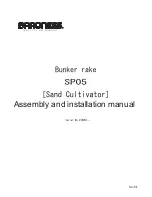
iom-clicsa-cf-eng
www.clima-flex.com
11
Installation and Application Information
Figure 4. Typical piping of a welded plate evaporator.
It is recommended that the field-installed water piping for the chiller include:
• Temperature sensors at evaporator inlet and outlet connections.
• Water pressure gauge connection taps and pressure gauges on evaporator inlet and outlet connections to measure water pressure
drop.
• Shut-off valves to isolate the unit from piping during unit maintenance.
• Minimum elevation changes and bends to minimize pressure drop.
• Vibration eliminators on supply and return water lines to reduce transmissions to the building.
• Thorough flushing of system water piping prior to making connections to the unit evaporator.
• Insulation of the piping, including a vapor barrier, helps prevent condensation and reduces heat loss.
NOTE:
Periodic water analysis and chemical treatment of the evaporator loop water is recommended immediately after unit
start-up
.
NOTE:
Failure to comply with these measures may result in performance and reliability problems.
P
Vibration
Eliminators
↑
↑
↑
↑
Isolation
Valves
Thermometer
Thermowell
↑
↑
Thermowell
↑
↑
Thermometer
Clima-Flex
Header's
↑
↑
Drain
Strainer
Flow
Switch
Air
Vent
Outlet
Inlet
WATER FLOW LIMITATIONS
Constant evaporator flow
Maximum flow rate and pressure drop are based on a 6°F temperature drop. Flow rates above the maximum values will result in
unacceptable pressure drops and may cause excessive erosion, which could lead to failure.
The minimum flow rate and pressure drop are based on a full load evaporator temperature drop of 16°F. Evaporator flow rates below
the minimum values may result in laminar flow leading to low pressure alarms, fouling and poor temperature control (See pressure drop
on page 16).
Variable evaporator flow
Reducing evaporator flow rate in proportion to load can reduce system energy consumption. The rate of flow change should be a
maximum of 10 percent of the flow per minute. For example, if the maximum design flow rate is 200 gpm and is to be reduced to a flow
rate of 140 gpm, the flow change is 60 gpm.












































